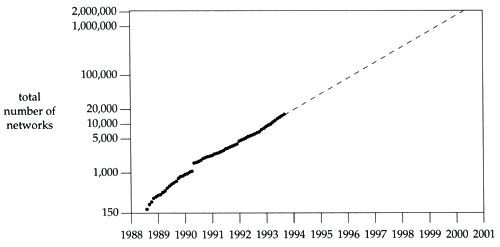Chapter 1
Chapter 1
| 1.1 | Calculate the maximum number of class A, B, and C network IDs. |
| A: | The value is 2 7 “ 2 (126) plus 2 14 - 2 (16,382) plus 2 21 “ 2 (2,097,150) for a total of 2,113,658. We subtract 2 in each calculation since a network ID of all zero bits or all one bits is invalid. |
| 1.2 | Fetch the file nsfnet/statistics/history.netcount using anonymous FTP (Section 27.3) from the host nic.merit.edu . This file contains the number of domestic and foreign networks announced to the NSFNET infrastructure. Plot these values with the year on the x-axis and a logarithmic y-axis with the total number of networks. The maximum value for the y-axis should be the value calculated in the previous exercise. If the data shows a visual trend, extrapolate the values to estimate when the current addressing scheme will run out of network IDs. (Section 3.10 talks about proposals to correct this problem.) |
| A: | Figure D.1 shows a plot of the values through August 1993. Figure D.1. Number of networks announced to NSFNET. |
| 1.3 | Obtain a copy of the Host Requirements RFC [Braden 1989a] and look up the robustness principle that applies to every layer of the TCP/IP protocol suite. What is the reference for this principle? |
| A: | "Be liberal in what you accept, and conservative in what you send." |
EAN: 2147483647
Pages: 378